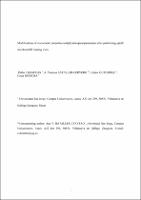Por favor, use este identificador para citar o enlazar este ítem:
https://repositorio.usj.es/handle/123456789/1113
Registro completo de metadatos
| Campo DC | Valor | Lengua/Idioma |
|---|---|---|
| dc.contributor.author | Bascuas, Pablo Jesús | - |
| dc.contributor.author | Bataller-Cervero, Ana Vanessa | - |
| dc.contributor.author | Gutiérrez, Héctor | - |
| dc.contributor.author | Berzosa Sánchez, César | - |
| dc.date.accessioned | 2024-02-08T10:26:34Z | - |
| dc.date.available | 2024-02-08T10:26:34Z | - |
| dc.date.issued | 2021-05 | - |
| dc.identifier.citation | Bascuas PJ, Bataller-Cervero AV, Gutierrez H, Berzosa C. Modifications of viscoelastic properties and physiological parameters after performing uphill and downhill running trials. J Sports Med Phys Fitness. 2021 May;61(5):625-635. doi: 10.23736/S0022-4707.20.11131-9. Epub 2020 Nov 4 | en_US |
| dc.identifier.issn | 1827-1928 | en_US |
| dc.identifier.uri | https://repositorio.usj.es/handle/123456789/1113 | - |
| dc.description.abstract | BACKGROUND: Trail running performance depends on many factors, including energy cost of running, biomechanical parameters and stiffness. The aim of this study was to examine the influence of different positive and negative slopes on metabolic cost, tight hemoglobin saturation, viscoelastic properties, and vertical peak impacts in physically active young runners. METHODS: Nine healthy male volunteers (26±5 years) performed two separate uphill and downhill sessions on an instrumented treadmill; both sessions were completed in a random order at a constant running speed with variable slopes from 0% to ±20%. Oxygen uptake (V̇O2), carbon dioxide production (V̇CO2), pulmonary ventilation (V̇E), respiratory exchange ratio, heart rate (HR), muscle oxygen saturation, vertical impacts, and muscle tone and stiffness were assessed. RESULTS: During downhill running, V̇O2peak and V̇CO2 significantly decreased, and impacts higher than 6G significantly increased with a negative slope. During uphill running, V̇O2peak, V̇CO2, V̇E, and maximum HR significantly increased. Minimum values of oxygen saturation and the vastus medialis tone significantly decreased and impacts of 4-5 G significantly increased with a positive slope. CONCLUSIONS: Metabolic demand increased proportionally with the uphill slope and showed a linear negative relationship with a light and moderate downhill slope. Vertical impacts of high G-forces increased during downhill running, data that indicate the importance of our ability to attenuate impacts. Finally, muscle tone and stiffness remained stable at all times, results that demonstrated their acute adaptation to running in the absence of extreme fatigue. | en_US |
| dc.format.mimetype | application/pdf | en_US |
| dc.language.iso | eng | en_US |
| dc.publisher | Edizioni Minerva Medica | en_US |
| dc.relation.requires | Adobe PDF | en_US |
| dc.rights | Attribution-NonCommercial-NoDerivatives 4.0 Internacional | * |
| dc.rights.uri | http://creativecommons.org/licenses/by-nc-nd/4.0/ | * |
| dc.subject | Trail running | en_US |
| dc.subject | Muscle oxygen saturation | en_US |
| dc.subject | Muscle tone | en_US |
| dc.subject | Stiffness | en_US |
| dc.subject | VO2 | en_US |
| dc.title | Modifications of viscoelastic properties and physiological parameters after performing uphill and downhill running trials (Versión aceptada) | en_US |
| dc.type | info:eu-repo/semantics/acceptedVersion | en_US |
| dc.relation.publisherversion | https://www.minervamedica.it/en/journals/sports-med-physical-fitness/article.php?cod=R40Y2021N05A0625 | en_US |
| dc.identifier.publicationfirstpage | sin numerar | en_US |
| dc.identifier.publicationlastpage | sin numerar | en_US |
| dc.identifier.doi | 10.23736/S0022-4707.20.11131-9 | en_US |
| dc.rights.accessrights | info:eu-repo/semantics/openAccess | en_US |
| Aparece en las colecciones: | Artículos de revistas | |
Ficheros en este ítem:
| Fichero | Descripción | Tamaño | Formato | |
|---|---|---|---|---|
| Modifications of viscoelastic version aceptada.pdf | 376,58 kB | Adobe PDF |  Visualizar/Abrir |
Este ítem está sujeto a una licencia Creative Commons Licencia Creative Commons

